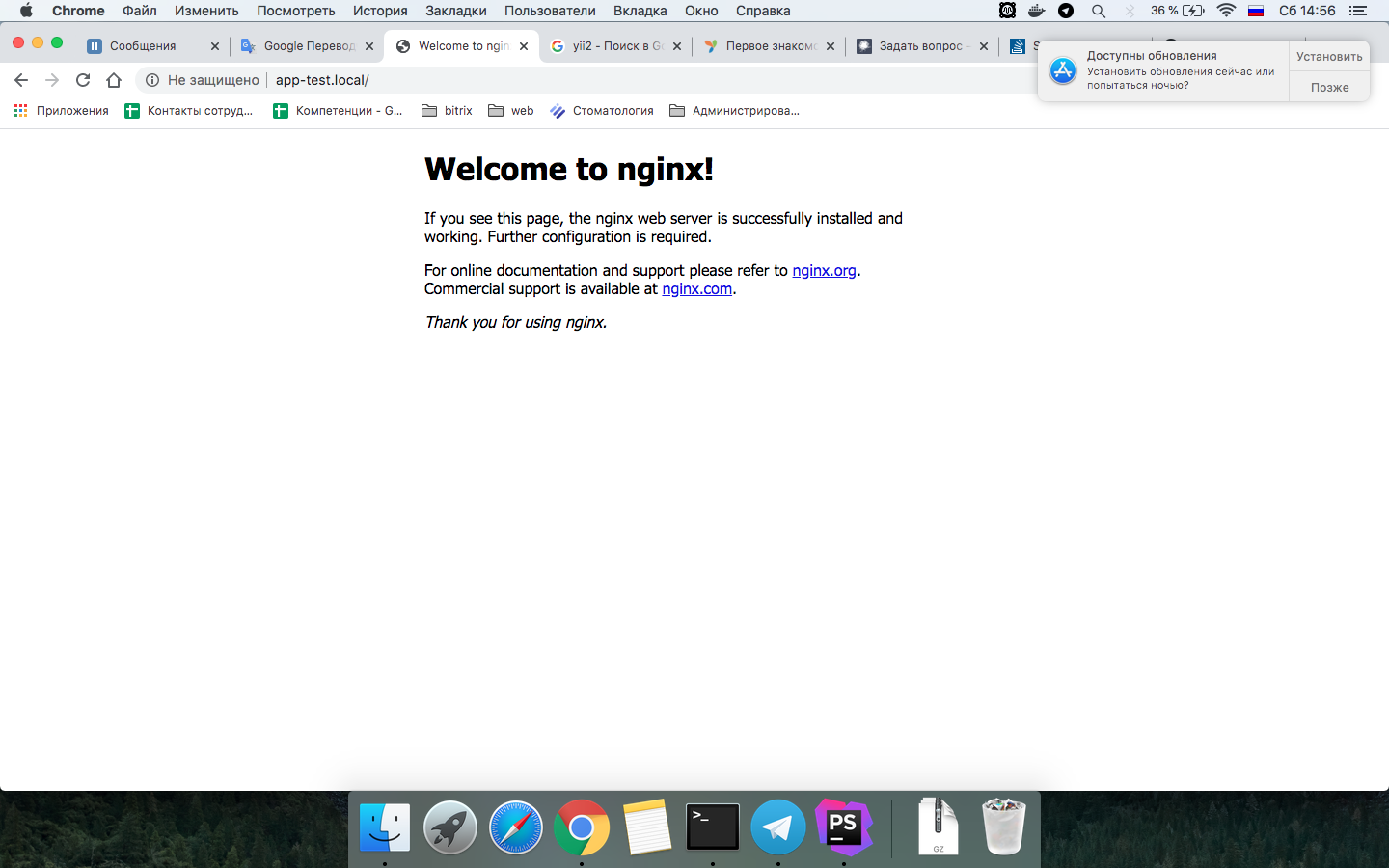Answer the question
In order to leave comments, you need to log in
How to open a project in nginx?
Used docker. For a poppy, to raise a web server, but my nginx has risen, but to open the project itself, this did not happen.
What configs did I use
docker-compose
version: '3'
services:
webserver:
container_name: nginx_kfnp_yii2
build:
context: .
dockerfile: ./docker/Dockerfile
environment:
XDEBUG_CONFIG: remote_host=host.docker.internal
PHP_IDE_CONFIG: serverName=localhost
ports:
- 80:80
volumes:
- ./:/var/www
links:
- db
depends_on:
- db
adminer:
image: adminer
restart: always
ports:
- 8080:8080
db:
container_name: mysql_kfnp_yii2
image: percona:latest
command: --default-authentication-plugin=mysql_native_password
restart: on-failure
ports:
- 3306:3306
expose:
- 3306
environment:
MYSQL_ROOT_PASSWORD: password
MYSQL_DATABASE: yii2basic
MYSQL_USER: mysqluser
MYSQL_PASSWORD: mysqluser#инструкция FROM - указывает на базе какого обараза будем собирать наш контейнер.
FROM debian:latest
#инструкция RUN - указывает какую команду нужно выполнить внутри образа. обновим индекс пакетов
RUN apt-get update
RUN apt-get install -y curl gnupg2 wget ca-certificates lsb-release
RUN echo "deb http://nginx.org/packages/mainline/debian `lsb_release -cs` nginx" \ | tee /etc/apt/sources.list.d/nginx.list \
&& curl -fsSL https://nginx.org/keys/nginx_signing.key | apt-key add - \
&& apt-get update
#Инструкция ENV задает переменные окружения с именем <key> и значением <value>.
#Это значение будет находиться в окружении всех команд потомков Dockerfile и могут быть использованы как обычные переменные окружения.
ENV TZ=Europe/Moscow
#указываем временную зону для нашего образа.
RUN ln -snf /usr/share/zoneinfo/$TZ /etc/localtime && echo $TZ > /etc/timezone
RUN apt-get install -y git nginx python3 perl \
software-properties-common nano wget zip unzip \
&& apt-get update
#устанавливаем php расширения
RUN apt-get install -y \
php7.3-fpm php7.3-common php7.3-mysql php7.3-gmp \
php7.3-curl php7.3-intl php7.3-mbstring php7.3-xmlrpc \
php7.3-gd php7.3-xml php7.3-cli php7.3-zip php7.3-soap \
php7.3-imap
#после завершения установок всех пакетов - обновим индекс
RUN apt-get update
RUN curl -sS https://getcomposer.org/installer | php && mv composer.phar /usr/local/bin/composer && composer global require hirak/prestissimo --no-plugins --no-scripts
#откроем 80 порт
EXPOSE 80
#добавим в контейнер конфигурационный файл php.ini, расположим его на стаднатрном для ubuntu месте
ADD ./docker/conf/php/php.ini /etc/php/7.3/nginx/php.ini
#обязательно добавим конфигурации xdebug
ADD ./docker/conf/php/xdebug.ini /etc/php/7.3/mods-available/xdebug.ini
#добавим конфигурацонный файл для виртуального сервера
ADD ./docker/conf/nginx/test.site.conf /etc/nginx/sites-enabled/test.site.conf
#укажим дирректорию /var/www как рабочую
WORKDIR /var/www
#запускаем процес apache2 в нормальном режиме (На переднем плане).
#Пока живет это процесс, живет и контейнер.
CMD ["nginx", "-g", "daemon off;"]server {
listen 80 default_server;
server_name app-test.local;
set $base_root /var/www/;
root $base_root;
charset UTF-8;
index index.php index.html;
location / {
root $base_root/frontend/web;
try_files $uri $uri/ /frontend/web/index.php$is_args$args;
location ~ ^/assets/.+\.php(/|$) {
deny all;
}
}
location /admin {
alias $base_root/backend/web/;
try_files $uri /backend/web/index.php$is_args$args;
location ~ ^/admin/assets/.+\.php(/|$) {
deny all;
}
}
location ~ ^/.+\.php(/|$) {
rewrite (?!^/((frontend|backend)/web|admin))^ /frontend/web$uri break;
rewrite (?!^/backend/web)^/admin(/.+)$ /backend/web$1 break;
include snippets/fastcgi-php.conf;
fastcgi_pass unix:/run/php/php7.3-fpm.sock;
}
location ~ /\. {
deny all;
}
}127.0.0.1 app-test.local
Answer the question
In order to leave comments, you need to log in
Separated nginx and php into separate container
docker-compose.yml
version: '3'
services:
app_php:
container_name: myata_php
build:
context: .
dockerfile: ./docker/Dockerfile
environment:
XDEBUG_CONFIG: remote_host=host.docker.internal
PHP_IDE_CONFIG: serverName=localhost
volumes:
- ./:/var/www
links:
- db
depends_on:
- db
nginx:
container_name: myata_nginx
image: nginx
volumes:
- ./docker/conf/nginx:/etc/nginx/conf.d/
- ./:/var/www
ports:
- 80:80
depends_on:
- app_php
adminer:
container_name: myata_adminer
image: adminer
restart: always
depends_on:
- db
ports:
- 8080:8080
db:
container_name: myata_mysql
image: percona:latest
command: --default-authentication-plugin=mysql_native_password
restart: on-failure
ports:
- 3306:3306
expose:
- 3306
environment:
MYSQL_ROOT_PASSWORD: password
MYSQL_DATABASE: myata
MYSQL_USER: ruslan
MYSQL_PASSWORD: kazan1811FROM php:7.3-fpm
RUN apt-get update && apt-get install -y \
git \
curl \
wget \
libzip-dev \
libfreetype6-dev \
libjpeg62-turbo-dev \
libmcrypt-dev \
libpng-dev zlib1g-dev libicu-dev g++ libmagickwand-dev --no-install-recommends libxml2-dev \
&& docker-php-ext-configure intl \
&& docker-php-ext-install intl \
&& docker-php-ext-install mbstring zip xml gd pdo_mysql \
&& pecl install imagick \
&& docker-php-ext-enable imagick \
&& pecl install xdebug-2.7.1 \
&& docker-php-ext-enable xdebug
RUN wget https://getcomposer.org/installer -O - -q \
| php -- --install-dir=/bin --filename=composer --quiet
WORKDIR /var/www
CMD ["php-fpm"]server {
# listen 443 ssl http2;
listen 80;
server_name app-test.local;
proxy_connect_timeout 3000;
proxy_send_timeout 3000;
proxy_read_timeout 3000;
client_max_body_size 20m;
send_timeout 300;
set $path "/var/www/frontend/web";
root $path;
access_log /var/www/frontend/runtime/logs/app-test-access.log;
error_log /var/www/frontend/runtime/logs/app-test-error.log;
charset utf-8;
sendfile on;
keepalive_timeout 65;
gzip on;
gzip_min_length 1024;
gzip_buffers 12 32k;
gzip_comp_level 6;
gzip_proxied any;
gzip_types text/plain application/xhtml+xml text/xml application/xml application/xml+rss text/css application/javascript;
location ~* ^.+\.(jpg|jpeg|gif|png|svg|js|css|mp3|ogg|mpe?g|avi|zip|gz|bz2?|rar|swf)$ {
expires 1d;
add_header Cache-Control "max-age=86400, public";
}
location / {
root $path;
index index.php index.html;
try_files $uri $uri/ /index.php?$args;
}
location ~* \.php$ {
fastcgi_param SERVER_NAME $host;
root $path;
fastcgi_pass app_php:9000;
fastcgi_index index.php;
fastcgi_param SCRIPT_FILENAME $path$fastcgi_script_name;
include fastcgi_params;
fastcgi_send_timeout 3000;
fastcgi_read_timeout 3000;
}
}
server {
if ($host = app-test.local) {
return 301 https://$host$request_uri;
} # managed by Certbot
listen 80;
server_name myata.local;
return 404; # managed by Certbot
}Didn't find what you were looking for?
Ask your questionAsk a Question
731 491 924 answers to any question